
For six weeks in the summer of 2023, students from the University of Notre Dame resided in the “City of Lights,” a European capital that many consider to be at the center of a wide range of human achievements. This immersive experience was supported by the Nanovic Institute for European Studies and focused on its strategic priority “peripheries.” From architecture to art to cuisine to fashion to film to language to literature and more, Paris is a veritable point of reference. Consequently, it is often thought to constitute the very center of many maps, no matter their orientation.
While the Notre Dame students who lived with host families in Parisian homes were eager to discover the centuries-long traditions of this location, their perspectives on Parisian practices were enhanced by careful attention to “peripheries” and to the presence of elements that they may not have expected to find before arriving on French soil. They aimed to discover multicultural aspects of the metropolis, looking especially for diversity and complexity that come from inventiveness and innovation. With the class and on their own, each student intended to discover a part of Paris that was surprising. Keeping an eye out for “Parisian Peripheries” was an activity they engaged in throughout their stay that required an openness to the multiplicity of influences on the French capital.
From center to périphérique, and vice versa
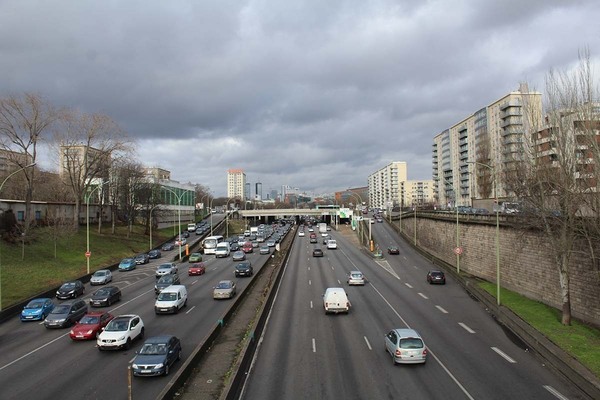
Unlike many cities, Paris is clearly defined in geographical terms thanks to a “ring road” that encircles it. A bustling highway known as the “périphérique” has effectively replaced the former walls and serves to demarcate the city from the suburbs.
To experience the dynamics of this barrier, Abel Stephen walked over a bridge that separates Paris from the urban sprawl that lies beyond and compared this barrier to an imposing staircase that distinguishes the touristic and trendy hill of Montmartre from the poorer neighborhoods next to it. Abel underscored in his study that these “physical manifestations of social division” are effective in their effort to keep people in socially distinct locations and that the distance they establish contributes to “work[ing] towards mitigating social unrest.”
The overt physical barriers posed by the peripheral wall and elaborate staircase to Montmartre are representative of the social stratification that permeates the city, separating Parisians from “others.” Abel considered the psychological effects on those populations told by the very structure of their city that they are not welcome there. Evoking a powerful passage from Faïza Guène’s novel “Discrétion,” Abel noted that “the weight of these barriers in places like Paris proper is crucial in fostering a divisive mindset among individuals on both sides of the barrier.” On July 10, 2023, the author Faïza Guène engaged with students during an hour-long classroom discussion of her work.
Jue Huang set out on a similar journey, walking from the edge of the city (the highway overpass) to the parks and monuments found near the Seine River that flows through its heart. In devoting his energies to moving from the outermost part of Paris toward its center, he found that “the periphery of Paris is no longer a fixed concept determined by physical boundaries but becomes contextualized.” He took pauses to observe people and was especially moved when he reached this conclusion: “[The periphery] is where people’s stories take place.”
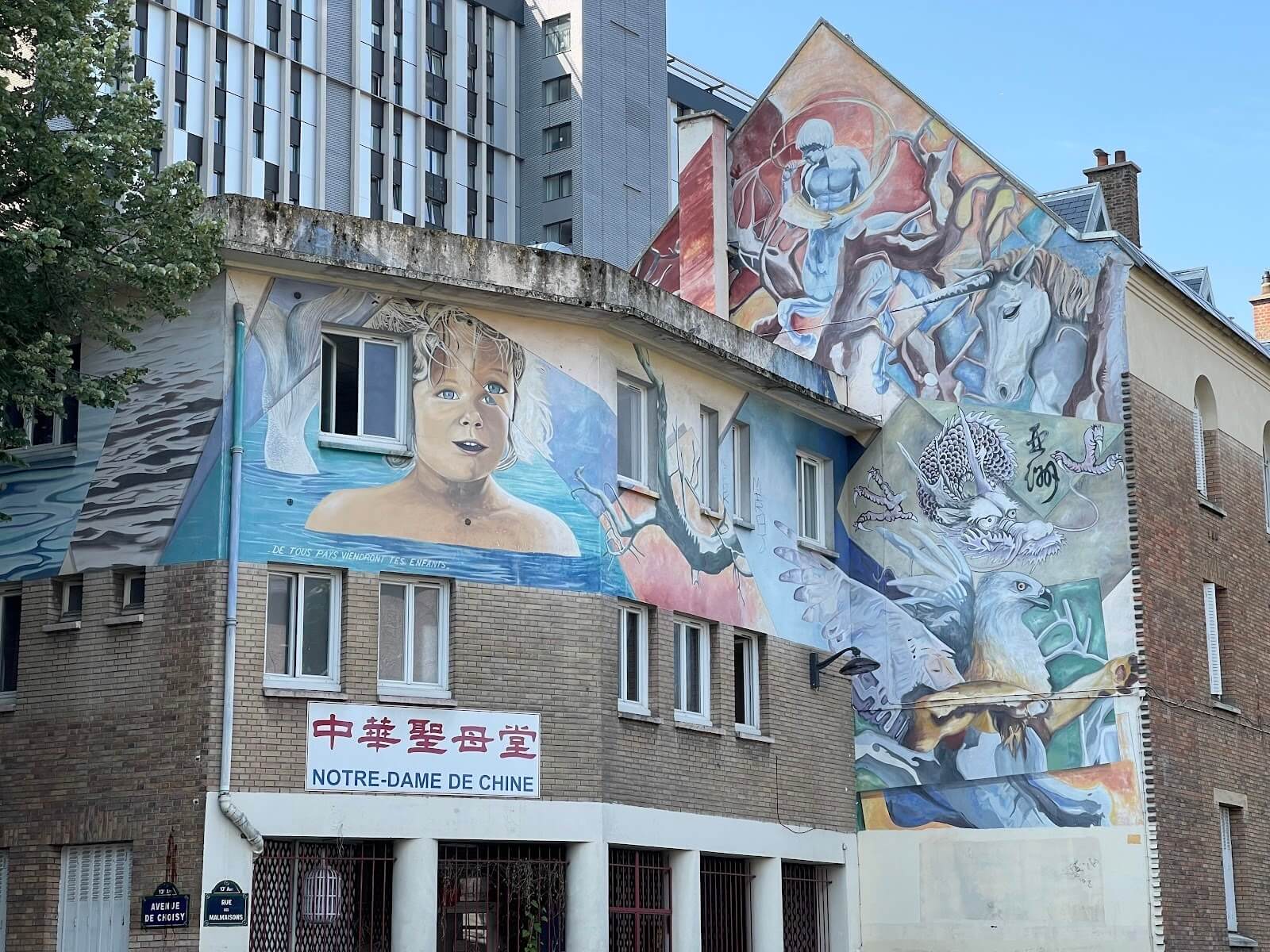
In his quest to understand what it means to be “Parisian,” Jue discovered that the city and its people simply cannot be reduced to a shared language, culture, or lifestyle.“When we examine the concept of a ‘peripheral’ Paris,” wrote Jue, “we must also consider, consciously or not, the idea of a ‘central’ Paris, of what it means to be Parisian.”
The arts explore peripheral Paris
Parisian stories find many forms of expression, of course. Street art drew the attention of Elsa Cox who examined the striking contemporary works that are making their mark in the city. Elsa highlighted the engagements of an artist collective called The Black Lines, which was founded in 2018. It currently encompasses over 300 artists (including street artists, graffiti artists, engravers, poster-makers, and banner makers) and reminds us that street art continually “flirts with legality” and thereby constitutes an art form that is at once “especially alluring to artists” and “difficult to execute.” It is, however, also a powerful means of commenting on “social and political issues, especially those affecting the artistic and Black communities.” Cox conducted research on the history of graffiti in Paris, noting that its fraught past paved the way for an artistic medium that, despite a growing reputation, remains largely in the “périphérique” of the art world. She writes of this tension:
Today, Paris is more willing to entertain street art because of its perceived artistic value, but while graffiti and street art may be decriminalized in the eyes of the public, they remain technically illegal unless you are a commissioned artist or are working on one of the “legal walls” that the city has designated. Commissions are … highly curated, very selective, and primarily focused on “humor” and beautification. This means they tend to be limited to a few well-known mural artists not interested in overtly political messages. Legal walls are great places for young artists looking to express themselves freely without the worry of repercussions, but they can prove to be stifling for more mature graffiti artists [because] … there are no protections on a mural, which means they are constantly being painted over.
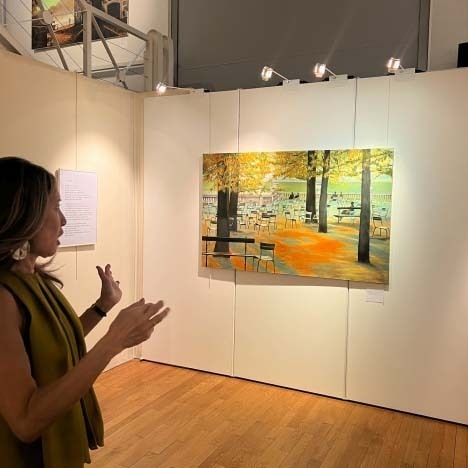
The original paintings of Japanese-born artist Yumiko Seki particularly spoke to Jackie Klein who emphasized in her analysis the fact that this creator is a “global citizen” whose work “highlights the quiet and charming aspects of Paris” and “speaks to the ephemeral nature of the feeling of acceptance for the outsider.” Jackie and other students took part in a guided tour of a temporary exhibit of Seki’s “brush, canvas, oil paints, and watercolor” creations and engaged in conversation with the artist as part of the summer program. Klein wrote:
“Yumiko Seki is at once both an outsider and an insider. She has called Paris her home for more than 40 years. She moved to the city in the 1980s after majoring in French literature during her years at university. From discussions in class with Prof. Alison Rice, we explored the phenomenon of how one could spend their entire lives in Paris but, if they are not born Parisian, are not ever truly accepted. I argue that Seki has successfully traversed from the peripheries into the coveted inner circle of Parisian acceptance. She is a stylish woman, who speaks perfect French and seems to be living a stereotypically fabulous life through her jet-setting lifestyle and artistic occupation. However, her art extends a welcoming arm out to interested viewers like myself who find such beauty in quiet simplicity, pulling us closer into that mysterious inner circle.”
Seki includes this message in her exhibit that gets at the heart of the Notre Dame students' experiences in Paris:
"Here and there I paint as I see. When I like the view, when the light takes hold of me, when a feeling is born in me. And Paris, where I have lived for over forty years, still moves me as much as the day I arrived."*

The memory of the American-born French dancer and singer Josephine Baker who catapulted to fame in Paris in the 1920s is kept alive throughout the city, in such prominent places as the Pantheon, a monument honoring the greatest individuals of the nation. In the National Museum of the History of Immigration, Camille Bice was captivated by a presentation about Baker that revealed the immense respect that this strong and successful woman, who was not originally from France, inspires today in such a profound way in French society.
Describing Baker as a “strong” individual, Bice argued that “although she is at the periphery, she utilizes her ‘otherness’— a term that I define as not being of traditional French, or European descent— to her advantage and, more importantly, to help others at the margins of postcolonial Parisian society.” Bice explained how “The “Vénus noire,” as Baker came to be known, “was able to leverage her identity as being on the periphery to jumpstart her successful career.” By “eroticizing exoticism and exploiting the French obsession with colonial power in shows and films,” Bice added, “[Baker] gained traction in her fight for racial equality.” Bice discovered that the fight against racism was just one of the social movements Baker was involved in, noting that the performer also denounced antisemitism, and discrimination against the LGBTQA+ community. “Josephine Baker’s legacy and inspiring efforts for universal human equality are what truly made her an icon and why she is still honored by the French and the global community today. With the current and historical unrest in the French banlieue due to injustices and racism faced by their people, the fight for equality, one that Baker fought, is needed even more.”
"Cake," ice cream, and the tensions of Parisian identity

Another foreign-born woman who continues to fascinate so many in France and around the world, long after she was executed by guillotine during the French Revolution, is Marie Antoinette. Elijah Jackson focused in his project on the ways this Queen of France, who was despised at the time of her death, has come to benefit from a more nuanced portrait as the years have gone by.
The city today bears many thoughtful reminders of this figure, ranging from a plaque at the Place de la Concorde, where the guillotine once stood, to the display of her personal items in the beautiful Carnavalet Museum dedicated to the history of Paris.
The legacy of Marie-Antoinette is perhaps best understood by way of an infamous but falsely attributed quote. Upon being informed that much of France’s Third Estate faced impending starvation because of a scarcity of bread, the young queen allegedly gave the blasé recommendation “Let them eat cake!”
Jackson discovered that this quote, which has long been said to demonstrate the young queen’s naïveté and disdain for the common people, was in fact never said by Marie-Antoinette.
Jackson pointed out that although her reputation has fluctuated over time, the controversial figure of Marie-Antoinette continues to transfix the millions of people who live in and visit Paris.
Marie Antoinette’s last handwritten words, a touching tribute to her children on a slip of paper that bears the stains of her teardrops, are posted upstairs in Le Procope, the very first café in Paris. This restaurant that the students visited together was founded in 1686 by an Italian chef who brought with him to the French capital coffee, ice cream, chandeliers, and marble tables —all foreign concepts that have since become quintessentially Parisian.
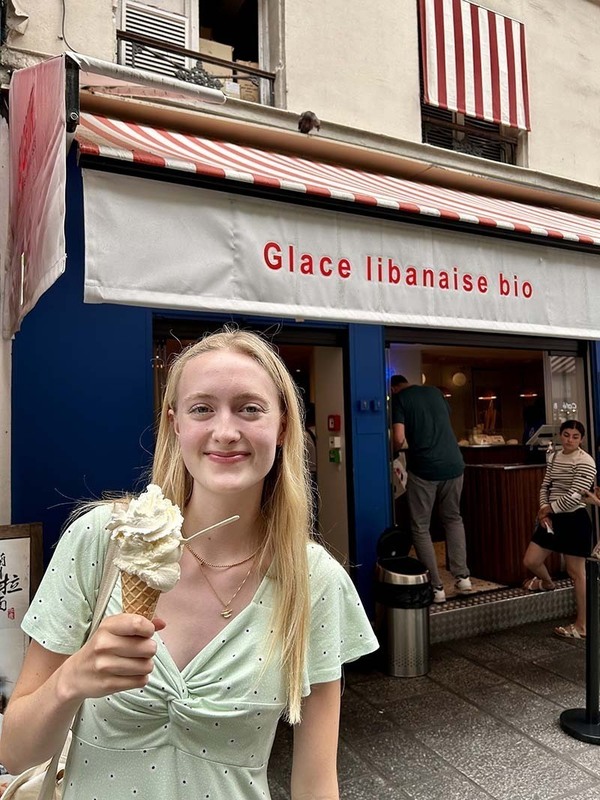
We might argue that these are the movements that the Notre Dame students astutely documented through their projects, taking account of both the older and newer aspects of the city that are helping to shape this urban landscape right now. In her well-developed study of the Lebanese ice cream phenomenon that is Bachir, Julia Jacobson focused on the colonial past and the postcolonial present that provide the background for the immense success of this Lebanese dessert establishment in Paris.
Beyond finding the immensely popular ice cream to be a refreshing treat in the heat of the Parisian summer, Jacobson noted that Bachir attracted a wide range of customers.
The restaurant is owned by a Lebanese family whose special recipe includes flavors that are more typically found in the Middle East. The chopped pistachios they put on top of their ice cream are one characteristic that makes a Bachir cone visibly different from more traditionally “French” shops.
Having researched the fraught political history between France and Lebanon, Jacobson was struck by the welcoming and convivial atmosphere in the ice cream shop. At Bachir, differences in race, country of origin, and even language mattered little as people from all walks of life enjoyed ice cream together.
Centering attention on Paris and accessibility
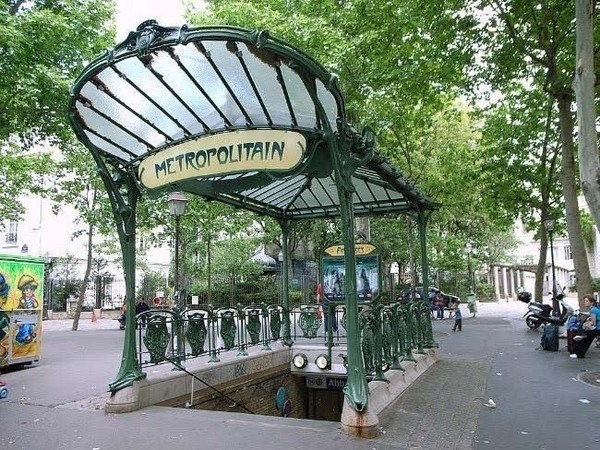
Finally, Jackeline Garcia concentrated on movement throughout the city, simultaneously marveling at the metro’s efficiency and lamenting its lack of accessibility for individuals with disabilities that would prevent them from navigating the multiple flights of stairs required to reach this form of transportation. She expressed particular concerns about the accommodation of the large numbers of people who will descend upon the city for the Olympic and Paralympic Games in July and August 2024.
“With the help of the bus lines in Paris that are almost completely wheelchair-friendly,” Garcia observed, “it seems that the needs of everyday residents with accessibility needs are almost met.” However, her research revealed that although the bus system is somewhat navigable for people with limited mobility, the metro largely is not, and the city’s housing accommodations pose an even greater problem. She explained: “Only about 5% of the hotels in the city are wheelchair-accessible. Even if they have an elevator, most apartments in the city are not accessible either. Although most cafes and restaurants have outdoor seating that completely bypasses the need to enter the establishment, bathrooms are often found on different floors of the building with the need to go up at least a couple of stairs. Despite a law requiring all public buildings and establishments to be accessible, finding yourself in an accessible one is quite rare.” City officials have acknowledged the limitations of the current infrastructure and have pledged to improve accessibility around the Olympic venues in particular, but Garcia remained skeptical that enough changes will be made before the summer of 2024. “The entire world will have its eyes on Paris,” she noted, “And the lack of disabled access will not be easily overlooked.”
An enriched perspective on the "City of Lights"
These students’ examinations of “Peripheral Paris” ultimately revealed that the city is not only characterized by the things that we might expect to be at the center, such as high fashion and fine cuisine, but it also necessarily mixes and mingles many different elements that make it difficult to discern, in the end, what belongs to “Paris proper” and what might be labeled “peripheral.”
Upon close observation, Notre Dame students found that the peripheral was present at the very center of Paris and that the city, the country, and even the continent were enhanced by the varieties they held—not outside their borders, but within.
Their projects expressed joy in the evolving definitions of the largest city in France and found in its malleability a convincing explanation for why Paris is one of the most impactful urban hubs in the world.
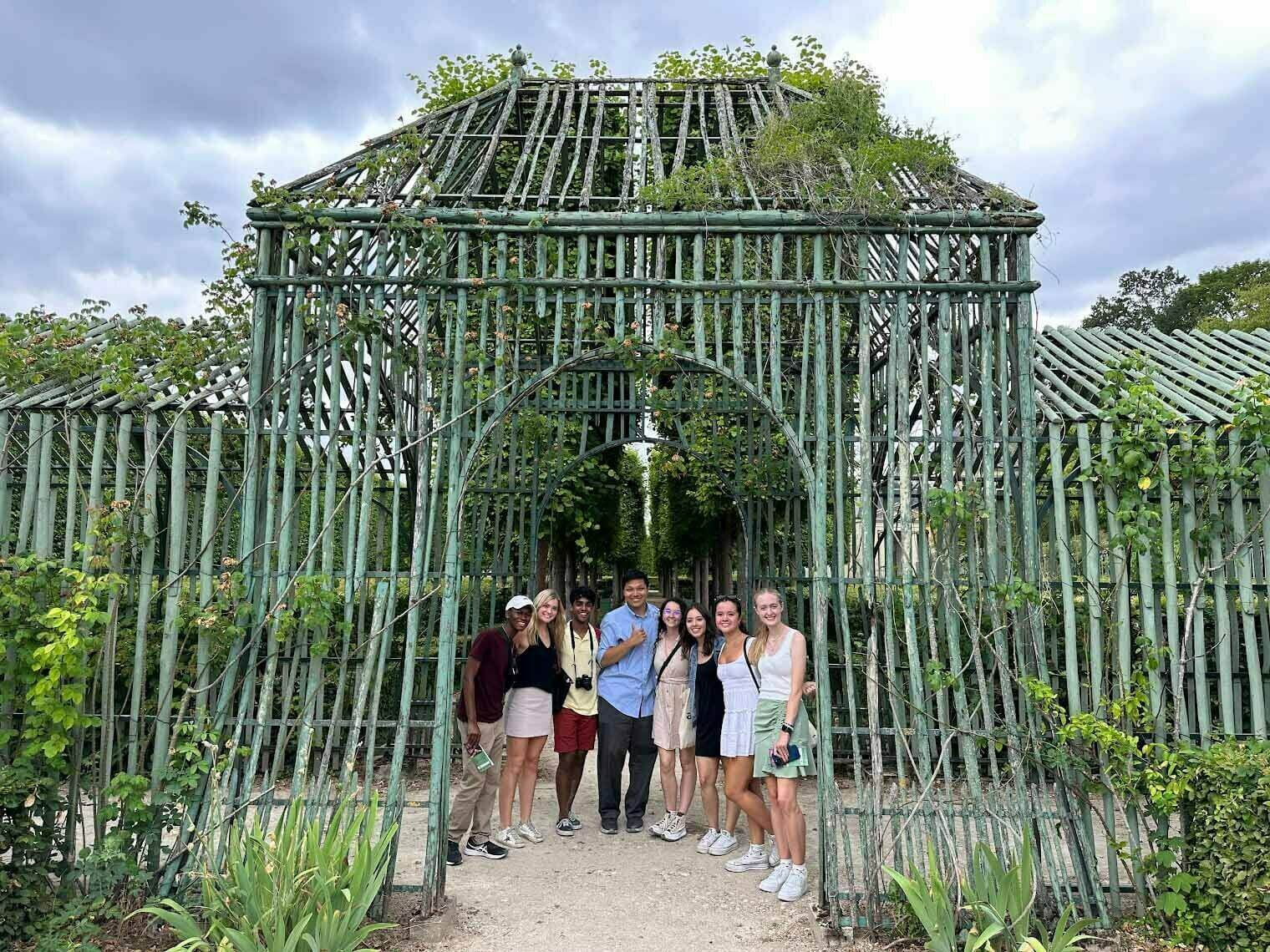
* Translated from French by Annie Seul, Nanovic Institute. Original text: "Ici et ailleurs je peins comme je vois, quand la vue me plait, quand la lumière me saisit, quand une émotion naît en moi. Et Paris, où je vis depuis plus de quarante ans, m'apporte toujours autant de sensations que le premier jour de mon arrivée."